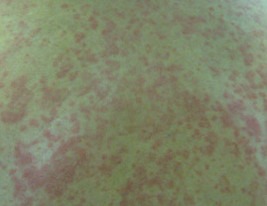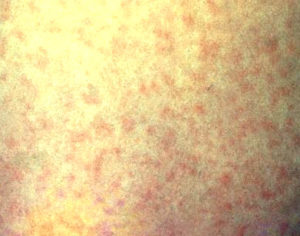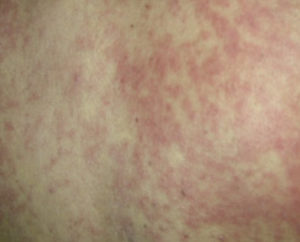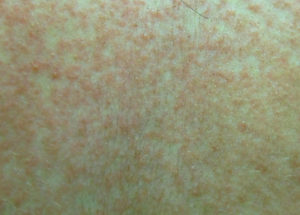What does Maculopapular Rash Look Like
While a maculopapular rash may form due to a variety of conditions, it has some distinguishing features in the pattern of papules and macules. The rash looks like some red bumps forming on a flat, red patch within the skin. In people with darker skin, the reddish background is unlikely to show up. The maculopapular rash is at times itchy usually lasting from two days to about three weeks depending on what is causing it. Again the cause of the rash will determine how quickly it appears in body and where it forms. The rash can spread anywhere on an individual’s body from the face to the limbs. Sometimes, a doctor may ask you to tell him or her where the rash started on your body. It may help to narrow down the potential causes.
Because a maculopapular rash appears when there is an infection or an allergy reaction, you may find that it develops along with other symptoms that may include:
- Vomiting
- Fever
- Dry skin
- Breathing troubles
- Headache
- Muscle pain
If these symptoms are accompanying the rash, it signifies an infection that could potentially be contagious. So, a doctor will need to evaluate the patient to diagnose the infection. For example, when a person has rubella virus, the rash tends to develop on the face and will spread to other area of the body including the trunk and extremities in about two to three weeks following the attack by the virus.
Causes
A person may develop a maculopapular rash because of different conditions some of which include drug reactions, allergies, bacterial and viral infections, and the body’s own systemic inflammation.
Drug reactions: A person may develop a maculopapular rash because of an allergy from a drug they may be using. Drugs in the penicillin class of medications such as Amoxicillin tend to trigger the maculopapular rash. The rash develops between four to 12 days after a person takes the medication. Reactions to medications may take up to eight days to bring out any symptoms. A patient may have a low-grade fever along with muscle pain. The maculopapular rash will fade away in about one to two weeks.
Infections: When a person has a bacterial or viral infection, it could cause the rash. The rash will form along with other symptoms such as headache, fever, breathing troubles, and muscle pain. Viral diseases likely to cause a maculopapular rash include HIV, Zika, herpes, ebola, scarlet fever, measles, EBV infection, hepatitis B and C infection, and the hand, food, and mouth disease.
Allergic reaction: If you have a rash breaking out immediately, it may be as a result of an allergy. The reaction in form of a rash occurs within minutes to hours of having exposure to an allergen. At times, the maculopapular rash could break out before hives form. An individual may have increased heart rate.
Systemic inflammation: An individual’s own systemic inflammation may as well cause the maculopapular rash. When there is an infection or an injury, inflammation sets in to help in the healing process – it’s the way the body responds to infections or injuries. An autoimmune response, infection, drug reaction, or allergic reaction may make the body’s immune system to start responding thus causing the maculopapular rash to develop.
How a Doctor Assesses the Rash – Diagnosis
If you develop a maculopapular rash, it would be important to see a doctor. The diagnosis can be difficult considering that many things including infections, allergies, and drug reactions can cause the rash. The doctor asks you your medical history. He or she may want to know if you recently traveled. A physical examination is conducted to look at where the rash started and how it has been spreading. The doctor will also ask questions to help in narrowing down and determining the cause.
The doctor may want to know when the rash started, and whether you had other symptoms accompanying the rash such as fatigue, sore throat, fever, conjunctivitis, or diarrhea. He or she may want to know the medications you are taking including OTCs and whether you have any chronic disease such as diabetes or heart condition.
Also, the doctor may ask about your past experience in having allergic reactions – have you experienced them before from insect bites, foods, or drugs? Another thing the doctor may want to know is whether you recently travelled to a place where there are mosquito-borne diseases like Chikungunya or Zika. A blood test may be ordered based on the history you give regarding your past experience and the rash. A skin biopsy may also be taken and referred to a skin disease specialist.
Maculopapular Rash – Treatment
The treatment will depend on what is causing the rash. If you are experiencing itching, you may be prescribed topical steroids or antihistamines to relieve it. OTC medications like Benadryl or hydrocortisone creams may also be used. Make sure you consult a doctor before you take any drug, even the OTC medications because you do not want to start treating symptoms before you know the cause.
For the case of a drug reaction, you may have to stop taking it and be given a substitute, but that should only be done by the doctor. If a viral infection has caused the rash appropriate treatment is given. For example, if Zika virus has caused the rash, there may be no specific treatment. A patient will be required to drink plenty of fluids, rest, and take OTC painkillers. An allergic reaction that has induced the rash will be treated using topical steroid creams. Probably wet wraps may help with inflammation. The doctor may prescribe you antihistamines to counter the allergy reaction.
The Bottom Line
The rash may cause pain and itchiness but it is unlikely that you will have complications. However, complications can arise from the underlying cause of the rash. For instance, a life threatening allergy reaction known as anaphylaxis may develop if you continue taking a drug that is triggering the rash. A patient may also develop stiff neck, headaches, or back pain due to an infection.
Zika virus causes an infection that presents with symptoms like the maculopapular rash. The complications of the virus may affect your baby, even when the symptoms are mild. The World Health Organization has stated that Zika is a public health emergency due to the high incidences of babies having microcephaly or underdeveloped head size. These babies are born to women believed to have had the rash during their first three months of pregnancy. Zika may be passed through mosquitoes and by having sexual intercourse with a person who has had the virus.
Maculopapular Rash – Pictures




